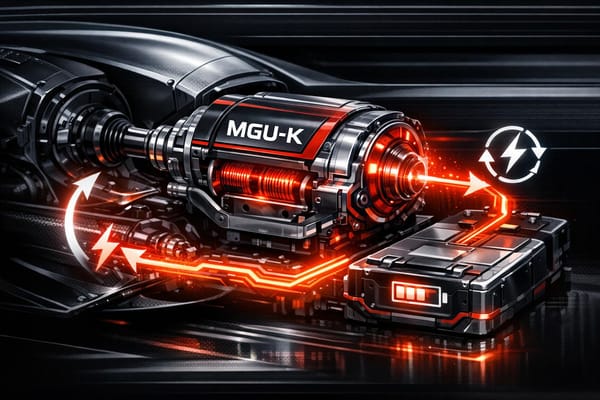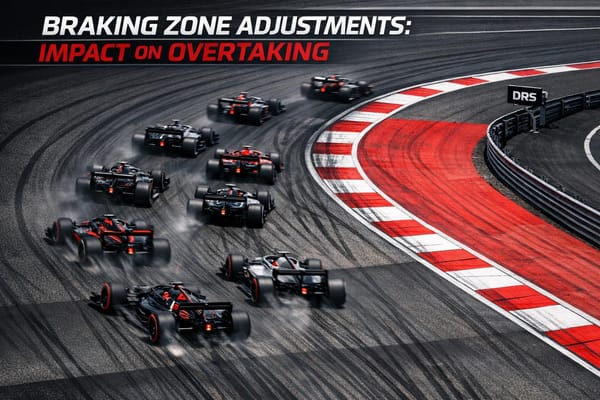Nico Hülkenberg: The German Veteran’s New Challenge at Sauber
Nico Hülkenberg returns to Sauber in 2025 to drive the team's transformation into Audi's works outfit, leveraging his experience for strategic growth.

Nico Hülkenberg returns to Sauber in 2025, aiming to rebuild the struggling team as it transitions into Audi's works team in 2026. With over 200 F1 races under his belt, Hülkenberg brings critical experience to a team that scored just 4 points in 2024 but has already improved to 16 points this season. His partnership with rookie Gabriel Bortoleto and collaboration with new leadership, including Mattia Binotto and Jonathan Wheatley, are key to Sauber's growth.
Key Points:
- 2025 Goals: Lay groundwork for Audi's 2026 entry into F1.
- Early Results: Sauber improved from 2024's 4 points to 16 points by May 2025.
- Hülkenberg’s Impact: Delivered a 7th-place finish in Melbourne and 5th in Spain, Sauber’s best results in years.
- Team Upgrades: New facilities, staff, and technical improvements under Audi's investment.
- Leadership Role: Hülkenberg provides technical feedback and mentors Bortoleto.
Quick Comparison (2013 vs. 2025):
| Factor | 2013 Sauber | 2025 Sauber |
|---|---|---|
| Team Status | Independent with Ferrari engines | Transitioning to Audi works team |
| Financial Position | Struggled with delayed payments | Backed by Audi’s investment |
| Key Results | 57 points, 7th in standings | 16 points, 8th in standings |
| Driver Role | Young talent proving himself | Veteran leader shaping the team |
Hülkenberg's return symbolizes Sauber's ambition to rise from the midfield and establish itself as a competitive works team under Audi by 2030.
Hulkenberg explains his decision to join Sauber next season
1. Nico Hülkenberg at Sauber (2025)
Nico Hülkenberg's return to Sauber couldn't have come at a more pivotal time for the team. After a tough 2024 season that saw them score just 4 points, the team needed a seasoned driver to guide them through what Hülkenberg describes as "a building year". Now sitting 8th in the 2025 Constructors' Championship with 16 points, Sauber has already shown signs of progress, even if they remain in the lower half of the standings. These early results hint at a season focused on strategic races and steady technical advancements.
Hülkenberg's influence was felt immediately. He opened the season with a seventh-place finish and followed it up with a remarkable fifth-place result in Spain - Sauber's best performance since Imola in 2022. Starting 15th after being eliminated in Q1, Hülkenberg delivered a masterclass, using an early pit stop strategy and a late-race pass on Lewis Hamilton to secure valuable points.
Beyond his on-track performances, Hülkenberg's technical expertise has been a game-changer for Sauber. Technical Director James Key praised the veteran’s feedback, saying:
"Nico has been truly brilliant so far. With his experience, he can explain calmly and clearly what the car is doing. He senses even the smallest details and can communicate them very well. That helps us enormously. The team has not seen such incisive driver feedback in years. We're getting completely fresh insights and new directions for development."
This input was especially impactful during the Spanish Grand Prix, where upgrades to the car improved its balance and consistency. Hülkenberg's fastest lap of 1:17.575 on Lap 63 highlighted the car's enhanced performance.
Hülkenberg’s role extends beyond racing; he’s helping prepare Sauber for its transformation into the Audi works team in 2026. With a $7 million salary, his responsibilities include both driving and shaping the team’s development during this transitional period. Reflecting on his broader mission, he noted:
"We are basically setting the foundations and the groundwork for the next couple of years, so to be honest, every day and every step of the way is already important."
Working alongside rookie teammate Gabriel Bortoleto, Hülkenberg is balancing mentorship with the challenge of refining the car’s performance. His methodical and patient approach is providing much-needed stability during a time of significant organizational change. New leadership, including former Ferrari executive Mattia Binotto as Chief Operating Officer and Jonathan Wheatley as Team Principal, adds further momentum to Sauber’s ambitious plans for the future.
2. Nico Hülkenberg at Sauber (2013)
Nico Hülkenberg's first stint with Sauber in 2013 paints a fascinating picture when compared to his current return. After a strong showing in 2012, where Sauber clinched sixth in the Constructors' Championship, there were high hopes for 2013. The introduction of the Sauber C32, featuring its standout tapered sidepods, fueled optimism that the team might break into the top five. However, the season turned out to be a rollercoaster ride, filled with challenges and unexpected breakthroughs.
The early part of the season was far from smooth. In the first 11 races, Sauber managed to collect only 7 points - all scored by Hülkenberg. Meanwhile, his teammate Esteban Gutiérrez struggled, earning just 6 points across the entire season and finishing 16th in the Drivers' Championship. In contrast, Hülkenberg amassed 51 points and outqualified Gutiérrez in 18 of the 19 races.
Discussing the team's struggles during this tough period, Hülkenberg candidly shared:
"Yeah, well, sure both the team and I aren't very happy with the recent performance of the car. We know we have to improve and we understand the issue, we've identified it but fixing it is now the challenge and it's up to us."
But the season wasn't entirely bleak. Things took a dramatic turn in the second half, starting with a standout performance in Italy. Hülkenberg's third-place qualifying result, trailing only the Red Bulls, marked a key moment in Sauber's recovery and helped push the team to seventh in the standings.
The revival was fueled by aerodynamic updates introduced at the Hungaroring and mid-season changes to Pirelli's tire strategy. As Team Principal Monisha Kaltenborn noted:
"We benefited maybe more than others from it [Pirelli's mid-season tire alterations]."
Hülkenberg's ability to manage tires played a critical role in this resurgence. One of his standout performances came at the Korean Grand Prix, where he started from a less-than-ideal grid position but fought his way to an impressive fourth-place finish. Reflecting on the race, he described it as:
"one of the best races in my career so far".
He elaborated further:
"We really punched above our weight. We shouldn't be in front of these cars but we are because we put everything together and we were quick in the important points [of the track]."
Tom McCullough, Sauber's Head of Track Engineering, praised Hülkenberg's performance in Korea:
"Today was a right front tire management exercise, knowing where to be quick and where to protect the car, and Nico executed that exactly as we wanted. He withstood intense pressure from top competitors."
Despite these on-track successes, the season was marred by financial troubles, leading to delayed payments. Even so, Sauber completed 90.88% of the total laps and ranked sixth in pit stop performance over the season.
Hülkenberg’s 2013 campaign with Sauber offers a glimpse into the grit and adaptability he brings to the table. It’s a story of navigating challenges, maximizing opportunities, and proving his worth under pressure - a narrative that continues to define his career.
Advantages and Disadvantages
Hülkenberg's return to Sauber in 2025 marks a pivotal moment in the team’s journey, signaling a shift in its resources, strategy, and overall competitive ambitions.
Back in 2013, Sauber operated as an independent team powered by Ferrari engines, grappling with tight budgets that hampered its ability to develop. Fast forward to 2025, and the team is deep into a transformation as it prepares to become Audi's works outfit in 2026. Under the leadership of Mattia Binotto, Sauber has doubled its workforce and is investing in cutting-edge facilities, including a new technical center in the UK.
This transformation brings clear benefits but also introduces significant challenges. On the plus side, the team has made strides in its technical capabilities. A new simulator and advanced simulation tools now give Hülkenberg access to resources he didn’t have during his 2013 stint. One team insider captured the determination driving these changes:
"Everyone in Switzerland and in Neuburg knows what's at stake. We're here to win races. Not next year or the year after, but we have a clear roadmap, and we will do everything to fulfil it".
However, Sauber’s competitive struggles remain a hurdle. In 2013, the team showed resilience, scoring 50 of its 57 points in the final eight races and securing seventh in the Constructors' Championship. In contrast, 2025 finds Sauber at the bottom of the standings, trailing Alpine by just one point as of May 30. While Hülkenberg’s seventh-place finish in Melbourne provided a glimmer of hope, the team has yet to find consistent success.
| Factor | 2013 Sauber | 2025 Sauber |
|---|---|---|
| Team Status | Independent with Ferrari engines | Transitioning to Audi works team |
| Financial Position | Struggling with delayed payments | Backed by Audi’s significant investment |
| Workforce | Limited resources | 400+ employees (200 recently hired) |
| Infrastructure | Basic facilities | New campus, UK tech center, advanced simulator |
| Championship Position | 7th (57 points) | Bottom of standings (1 point behind Alpine as of May 30) |
| Hülkenberg's Role | Young talent proving his worth | Veteran leader guiding transformation |
The team’s growing infrastructure is complemented by a shift in leadership dynamics. Audi F1 CEO Andreas Seidl highlighted Hülkenberg’s pivotal role:
"With his speed, his experience and his commitment to teamwork, he will be an important part of the transformation of our team – and of Audi's F1 project".
This is a significant change from 2013, when Hülkenberg’s focus was on showcasing his talent in a competitive midfield environment.
Still, the road ahead is far from smooth. Unlike 2013’s late-season surge, 2025 is about laying the groundwork for Sauber’s future as a works team. Building consistency remains a challenge. Team Principal Jonathan Wheatley expressed cautious optimism about the team’s upgrades for the Spanish Grand Prix:
"Barcelona should give us a clear picture of how our new upgrade package will affect our competitiveness... The team has been working hard back home in Hinwil and our focus is on getting familiar with the new parts... With a view to putting ourselves in a more consistently competitive position heading into the next phase of the season".
Mattia Binotto also acknowledged the deeper challenges, stating:
"A lot needs to be done to alter the squad's mindset and develop a winning mindset".
This highlights the cultural and performance barriers that go beyond technical advancements.
For Hülkenberg, 2025 is shaping up to be a foundational year. Representing a German factory team like Audi brings both pride and pressure - elements that weren’t as pronounced during his 2013 campaign. This dual responsibility of driving progress while managing expectations adds an extra layer of complexity to his role.
Conclusion
Nico Hülkenberg's return marks a pivotal step as Sauber prepares for Audi's highly anticipated entry into Formula 1. With over 200 F1 races under his belt, Hülkenberg brings the kind of seasoned expertise Sauber needs during this transformative phase.
Comparing his journey from 2013 to 2025 highlights a remarkable evolution. Back in 2013, Hülkenberg displayed undeniable potential despite the financial hurdles Sauber faced. Fast forward to 2025, and he’s spearheading growth and investment. His immediate impact was evident at the 2025 Australian Grand Prix, where he scored more points in a single race than the team managed throughout the entire 2024 season.
Hülkenberg's technical acumen and precise feedback will be crucial as Sauber develops its 2026 car. His familiarity with the team's inner workings, dating back to his 2013 stint, gives him a unique advantage in identifying areas for improvement. Armed with new resources, he’s well-positioned to help Sauber make significant strides. His calm yet determined approach will undoubtedly play a key role in the team’s rebuilding process.
The timing of his return is no coincidence. Rather than stepping into the Audi era cold in 2026, Hülkenberg now has a full season to integrate with the team and establish a foundation for consistent point-scoring - a priority emphasized by Mattia Binotto.
His presence not only addresses immediate challenges but also aligns with Audi’s long-term ambitions, including their sights on title contention by 2030 . Success will hinge on earning championship points and reshaping Sauber’s competitive culture, setting the stage for the team to emerge as a formidable force in the Audi era. This partnership lays a clear path for Sauber’s future in Formula 1.
FAQs
What challenges does Nico Hülkenberg face as Sauber prepares to become Audi's works team in 2026?
Nico Hülkenberg's Challenges in Sauber’s Transition to Audi
Nico Hülkenberg has a pivotal role in guiding Sauber through its transformation into Audi’s works team by 2026. One of his primary tasks will be boosting Sauber’s performance on the track to align with Audi’s high expectations. With his extensive experience, he’ll also need to navigate the complexities of the new technical regulations set to roll out in 2026, offering strategic insights and adapting swiftly to changes.
Beyond the technical side, Hülkenberg is expected to strengthen team dynamics as Audi’s presence within Sauber grows. As a veteran driver, he’ll not only focus on his own performance but also take on the responsibility of mentoring younger teammates, setting a strong example both on and off the track. Another significant hurdle will be blending Audi’s corporate culture with Sauber’s established identity - a process that will demand careful coordination and collaboration across the team.
How will Nico Hülkenberg's previous experience with Sauber in 2013 shape his return to the team in 2025?
Nico Hülkenberg's previous experience with Sauber back in 2013 gives him a valuable edge as he returns to the team in 2025. Thanks to his past involvement, he already understands how the team operates and can seamlessly integrate himself into its framework. This familiarity allows him to provide focused feedback to tackle some of the lingering challenges the team faces.
During his earlier stint, Hülkenberg showcased impressive performances, setting a high bar for both himself and the team. His wealth of experience and deep technical expertise are expected to be crucial in refining Sauber's race strategies and boosting their competitiveness this season. The team has already highlighted his contributions, especially in areas where previous drivers had difficulty making a significant impact.
What upgrades and strategies is Sauber focusing on to boost their performance for the 2026 F1 season?
Sauber is gearing up for the 2026 Formula One season with an eye on pushing boundaries in design and performance. With Audi set to take the reins, the team is focusing on aerodynamics, improved vehicle balance, and greater efficiency to align with the upcoming regulations. These changes will involve adapting to smaller, lighter cars equipped with active aerodynamics and a stronger emphasis on hybrid power units.
In tandem with these adjustments, Sauber is collaborating closely with Audi to seamlessly integrate their future power unit, which is expected to play a pivotal role in enhancing the team's competitiveness. This partnership underscores Sauber's determination to emerge as a formidable force under Audi's leadership in the ever-evolving world of Formula One.




